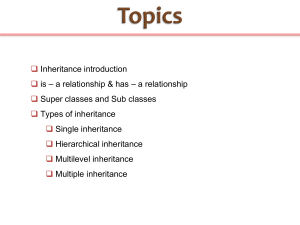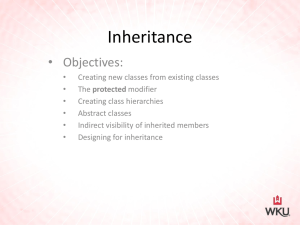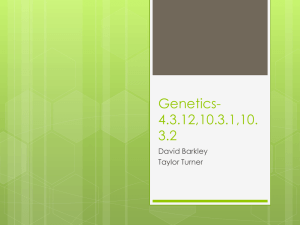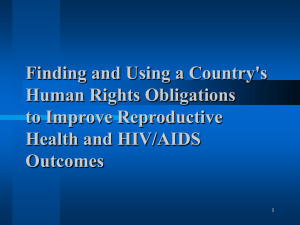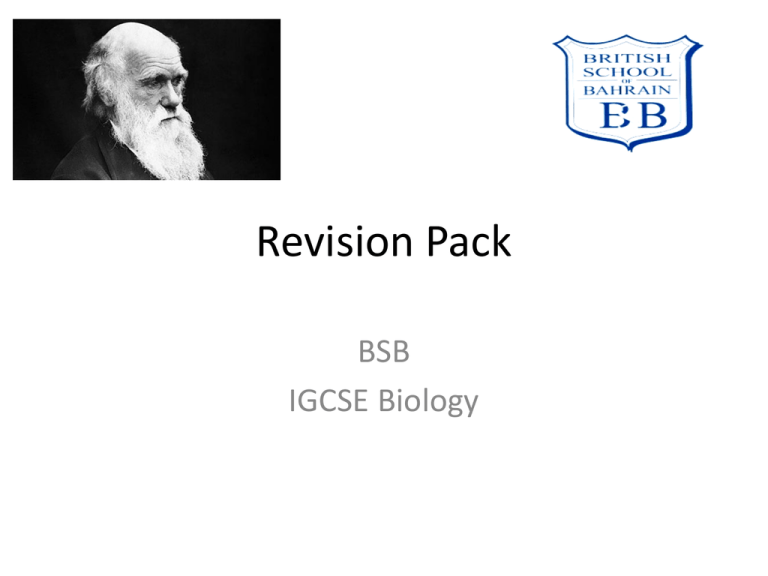
Revision Pack
BSB
IGCSE Biology
SECTION E:
Variation and Selection
Term 4/5
approx 13 lessons
Instructions
• You can use the following statements for your
revision. They are taken directly from the
specification.
• They key terms are also listed. Your revision
should enable you to recognise and use these
key terms in the test.
Trigger Words
• Trigger words at the start of the statements
give you an idea of what it is that you might
be asked to do in an exam question
• You can compare these to the exam glossary
that makes up the last two slides of this pack
Important trigger words for IGCSE
Easy
Recognise
Trigger Words
Recall
Describe
Explain
Hard
Understand
Evaluate
Inheritance
3.14 recall that the nucleus of a cell contains
chromosomes on which genes are located
3.15 understand that a gene is a section of a
molecule of DNA
3.16 describe a DNA molecule as two strands
coiled to form a double helix, the strands
being linked by a series of paired bases:
adenine (A) with thymine (T), and cytosine (C)
with guanine (G)
Inheritance
Nucleus
Chromosome
Gene
DNA molecule
Strands
Double helix
Base pairs
Adenine (A) and Thymine (T)
Cytosine (C) and Guanine (G)
Inheritance
3.17 understand that genes exist in alternative
forms called alleles which give rise to
differences in inherited characteristics
3.18 recall the meaning of the terms: dominant,
recessive, homozygous, heterozygous,
phenotype, genotype and codominance
Inheritance
Genes
Alleles
Inherited characteristics
Dominant
Recessive
Homozygous
Heterozygous
Phenotype
Genotype
Codominance
Inheritance
3.19 describe patterns of monohybrid
inheritance using a genetic diagram
3.21 predict probabilities of outcomes from
monohybrid crosses
Inheritance
Monohybrid inheritance
Genetic diagram
Probabilities
Monohybrid crosses
Inheritance
3.20 understand how to interpret family
pedigrees
Inheritance
Interpret
Family pedigrees
Inheritance
3.22 recall that the sex of a person is controlled
by one pair of chromosomes, XX in a female
and XY in a male
3.23 describe the determination of the sex of
offspring at fertilisation, using a genetic
diagram
Inheritance
Sex chromosomes
XX (female)
XY (male)
Sex determination
Fertilisation
Genetic diagram
Inheritance
3.24 understand that division of a diploid cell by
mitosis produces two cells which contain
identical sets of chromosomes
3.25 understand that mitosis occurs during
growth, repair, cloning and asexual
reproduction
Inheritance
Cell division
Diploid cell
Mitosis
Identical chromosomes
Growth
Repair
Cloning
Asexual reproduction
Inheritance
3.26 understand that division of a cell by meiosis
produces four cells, each with half the number
of chromosomes, and that this results in the
formation of genetically different haploid
gametes
Inheritance
Cell division
Meiosis
Haploid gametes
Inheritance
3.27 understand that random fertilisation
produces genetic variation of offspring
3.28 recall that in human cells the diploid
number of chromosomes is 46 and the
haploid number is 23
Inheritance
Random fertilisation
Genetic variation
Offspring
Human diploid number (46)
Human haploid number (23)
Inheritance
3.29 understand that variation within a species
can be genetic, environmental, or a
combination of both
3.30 recall that mutation is a rare, random
change in genetic material that can be
inherited
Inheritance
Variation
Species
Genetic
Environmental
Mutation
Random change
Inheritance
3.31 describe the process of evolution by means
of natural selection
Inheritance
Evolution
Natural selection
Inheritance
3.32 understand that many mutations are
harmful but some are neutral and a few are
beneficial
3.33 understand how resistance to antibiotics
can increase in bacterial populations
Inheritance
Mutation
Harmful
Neutral
Beneficial
Antibiotic resistance
Bacterial populations
Inheritance
3.34 understand that the incidence of
mutations can be increased by exposure to
ionising radiation (for example gamma rays,
X-rays and ultraviolet rays) and some
chemical mutagens (for example chemicals in
tobacco).
Inheritance
Incidence of mutations
Ionising radiation
Gamma rays
X-rays
Ultraviolet rays
Chemical mutagens
Tobacco
Selective breeding
5.10 understand that plants with desired
characteristics can be developed by selective
breeding
5.11 understand that animals with desired
characteristics can be developed by selective
breeding.
Selective breeding
Plants
Animals
Desired characteristics
Selective breeding
Trigger Words Glossary





